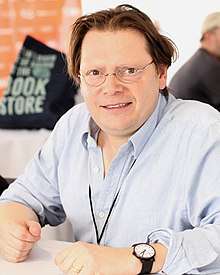Edward Carey (novelist)
Edward Carey (born April 1970, in North Walsham, Norfolk, England)[1] is a playwright and novelist. He has written several adaptations for the stage, including Patrick Süskind’s The Pigeon and Robert Coover’s Pinocchio in Venice. His own plays include Sulking Thomas and Captain of the Birds. He collaborated with Eddin Khoo on the wayang kulit translation of Macbeth called Macbeth in the Shadows.[2]
Edward Carey | |
|---|---|
 Carey at the 2018 Texas Book Festival. | |
| Born | April 1970 (age 50) North Walsham, Norfolk, England, United Kingdom |
| Occupation | Playwright, novelist |
| Genre | Theatre, fiction |
Biography
Carey attended the Nautical College, Pangbourne, as did his father and grandfather. He did not enlist in the Royal Navy, however.[3] Instead, he participated in the National Youth Theatre and attended the University of Hull, earning a degree in drama in 1991.[3]
As a young Man, Carey worked in Madame Tussauds wax museum (London), which would figure into his historical novel, Little.[4]
Carey attended the University of Iowa International Writing Program and taught at the Iowa Writers' Workshop.
He has lived in many European locations, but, in 2006, he took up permanent residence in the United States, settling in Austin where he teaches at the University of Texas.[4] He is married to the writer Elizabeth McCracken.[5]
Reviews
"Though Edward Carey seems to intend his first novel, Observatory Mansions, to be an unsentimental, surrealist romance, it's really a paean to loneliness. For the book is never so interesting as when its characters are despairing and alone. All goes well then for the first hundred pages, where Carey lays out the solitude housed in Observatory Mansions, a greying apartment building where Francis Orme, the book's narrator, cultivates a secret life of stillness and theft."[6]
"From Richardson to Dickens to Ackroyd, English literary fiction seems to favour the elephantine. Miniaturists – Austen, Pym perhaps, Brookner – are rarer, less typical. Edward Carey is most decidedly a miniaturist. "Miniature things move people," he remarks, two dozen pages into his second novel; and again, a similar distance from the end."[7]
"An imaginary city: this is a time for such a vision, especially for New Yorkers, whose city has always been in flux, though perhaps never more painfully and self-consciously than today. Entralla, the fictitious metropolis at the heart of Edward Carey's second novel, exists not only in our imagination and in the pages of Alva & Irva (which serves as Entralla's one and only guidebook) but in the form of tiny plasticine models of its streets and houses, seen in the appealingly smudgy photographs that punctuate the novel. A re-creation of Entralla also appears in the story of Alva & Irva, since the twins of the book's title are the designer and sculptor, respectively, of their native city in miniature."[8]
Works
- Edward Carey (2000). Observatory Mansions. ISBN 978-0-679-31130-0.
- Edward Carey (2003). Alva & Irva: The Twins Who Saved a City. Picador. p. 214. ISBN 978-0-330-39605-9.
- Edward Carey. L'observatoire. ISBN 978-2-85940-781-0.
- Edward Carey (2014). Heap House: The Iremonger Trilogy: Book One. ISBN 978-1-46830-953-9.
- Edward Carey (2014). Foulsham, Iremonger Book Two. ISBN 978-1-47140-160-2.
- Edward Carey (2015). Lungdon, Iremonger Book Three. ISBN 978-1-46830-955-3.
- Edward Carey (2018). Little: A Novel. ISBN 978-0-52553-432-7.
Awards
- Fellow, Guggenheim Foundation (2019)[3]
References
- Author's Website
- Bakar, Sharon (19 June 2005) Writer who draws out books, The Star (Malaysia) Archived 23 October 2012 at the Wayback Machine
- "John Simon Guggenheim Foundation". John Simon Guggenheim Memorial Foundation. 2019. Retrieved 9 February 2020.
- Timberg, Scott (29 November 2018). "The slightly twisted vision of Edward Carey and his imagined Madame Tussaud". Los Angeles Times. Retrieved 9 February 2020.
- 2008–2009 Radcliffe Institute Fellows, Radcliffe Institute for Advanced Study, Harvard University
- Valdes, Marcela (18 April 2001). Edward Carey: Observatory Mansions Archived 6 June 2011 at the Wayback Machine, Minneapolis City Pages
- Greenland, Colin (17 May 2003). "Small world", The Guardian
- Harrison, Carey (23 March 2003). One Word: Plasticine, The New York Times
External links
| Wikimedia Commons has media related to Edward Carey. |